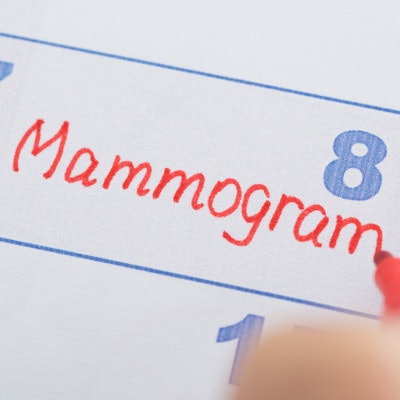
Annual breast cancer screening with mammography starting at age 40 results in a nearly 40% reduction in breast cancer-specific deaths compared with screening at less-frequent intervals, according to a study published online August 21 in the journal Cancer.
The findings offer further evidence that starting screening early is of benefit to women, said lead author Dr. Elizabeth Kagan Arleo of Weill Cornell Medicine and NewYork-Presbyterian Hospital in a statement released by Cornell.
"Our findings are important and novel because this is the first time the three most widely discussed recommendations for screening mammography have been compared head to head," she said. "Our research would be put to good use if, because of our findings, women chose to begin annual screening mammography starting at age 40. Over the long term, this would be significant because fewer women would die from breast cancer."
Best practice
When to start breast cancer screening, how often to receive it, and for how many years are often-debated questions, Arleo and colleagues wrote. The group used 2009 and 2015-2016 Cancer Intervention and Surveillance Modeling Network (CISNET) breast cancer models to estimate how many breast cancer deaths might be prevented according to three screening protocols:
- Annual screening starting at age 40 (recommended by the American College of Radiology and the Society of Breast Imaging)
- Annual screening between 45 and 54, then biennial screening between 55 and 79 (the basic American Cancer Society recommendation, called the hybrid recommendation)
- Biennial screening between 50 and 74 (the U.S. Preventive Services Task Force's recommendation)
The researchers also incorporated an assessment of risks associated with screening, including recalls and biopsies, into their analysis.
They found that annual screening starting at age 40 would result in the greatest reduction in breast cancer-specific deaths: a nearly 40% reduction, compared with 31% and 23% for the other two protocols.
| Comparison of breast screening strategies | |||
| Measure | Annual screening starting at 40 | Annual screening, 45-54; biennial screening, 55-79 | Biennial screening, 50-74 |
| Percent mortality reduction | 39.6% | 30.8% | 23.2% |
| Breast cancer deaths averted | 11.9 | 9.2 | 6.9 |
| Life-years gained (LYG) | 189 | 149 | 110 |
| No. needed to screen (NNS) per death averted | 84 | 108 | 144 |
| NNS per LYG | 5.3 | 6.7 | 9.1 |
"Following the first recommendation averts the most breast cancer deaths (11.9 per 1,000 women screened, 29% more than the hybrid recommendation and 71% more than the third recommendation) and gains the most life-years," the researchers wrote.
The group acknowledged that, using a theoretical cohort of women who turned 40 in 2000, the risks of screening mammography in terms of recalls and benign biopsies would be highest under the first protocol. But women may be willing to accept the risk, according to Arleo and colleagues.
"Based on the 2009 CISNET estimates, on average a woman getting annual screening starting at age 40 could expect to be recalled from screening for a benign diagnostic workup once every 13 years, and could expect to undergo a benign biopsy once every 187 years," the authors wrote. "These risks are considerably lower than most women have expressed willingness to accept."
In any case, the study shows that annual mammography starting at age 40 is the most effective way to reduce breast cancer deaths, according to contributing author R. Edward Hendrick, PhD, from the University of Colorado, Denver.
"More lives are saved by starting screening annually at age 40 than the other protocols," he told AuntMinnie.com. "It means more mammograms performed, and more callbacks, but these 'risks' are not on the same scale as saving a life."
Finding a better test
In an accompanying editorial, Dr. Otis Brawley, chief medical officer of the American Cancer Society, noted one of the study's limitations: namely, that the CISNET models assume 100% compliance and that all women have access to quality screening, diagnostics, and treatment.
"However, numerous studies have shown that a substantial proportion of American women with breast cancer receive less than adequate care," Brawley wrote. "Indeed, one of the greatest frustrations of my career is there is not enough discussion about the need to provide better cancer care to a substantial proportion of Americans."
In the end, it is ultimately up to the individual to decide how many false-positive mammograms and biopsies are too many to save one life -- and to be aware of mammography's limitations, he wrote.
"Acknowledging the limitations of mammography is often misinterpreted as being against mammography screening," he concluded. "In fact, it is not. It is only through appreciating both the benefits and limitations of mammography that we can use it effectively -- that is, to prevent the largest number of deaths possible. It is also necessary to set the scientific agenda so that we can find a better test."




















